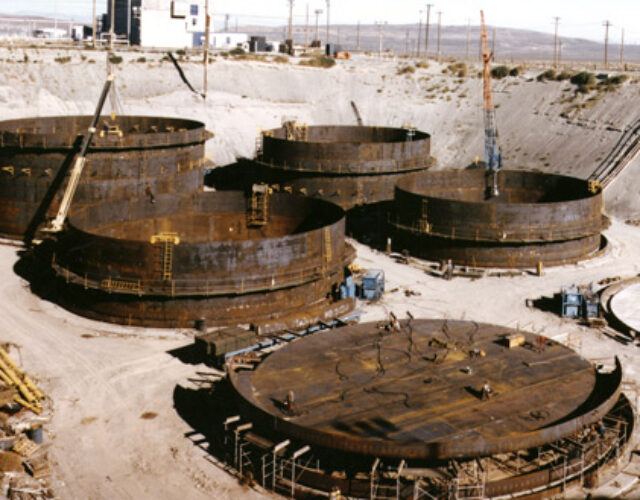As Americans flocked to wartime factory jobs in 1943, notices began appearing nationwide: “War Workers Needed on Southeastern Washington Construction Project. Attractive Scale of Wages.” Laborers who answered these terse ads soon were erecting massive concrete buildings on a remote, windy plain circled by a 50-mile loop of the Columbia River. Few of the thousands who worked 60-hour weeks on the dusty reservation during the next two years knew what they were doing.
Headlines revealed the secret in August 1945: the Hanford site was making plutonium for nuclear weapons, including the bomb that destroyed Nagasaki, Japan. From 1944 through 1988 Hanford’s nuclear reactors produced more than 67 metric tons of plutonium—two-thirds of the U.S. military’s stockpile—for the Atomic Energy Commission and its successor, the Department of Energy (DOE). Since the Cold War sputtered to a close, Hanford operators have faced an even more challenging mission: managing leftover radioactive waste.
Cleaning up Hanford—a vast industrial complex half the size of Rhode Island—is one of the world’s largest environmental remediation projects. The central challenge lies out of sight: 177 underground storage tanks, built starting in the 1940s, that hold more than 56 million gallons of highly radioactive waste. The tanks are made of carbon steel surrounded with reinforced concrete; most have single-shell steel walls, although some built from the late 1960s to the mid-1980s have double-shell walls. Most were designed to be used for no more than 20 years. After that time, managers assumed, waste would be sent to some permanent disposal site.
The waste was generated when workers reprocessed irradiated uranium fuel rods to recover plutonium for nuclear weapons. Technicians dissolved fuel rods in nitric acid and then separated plutonium from the resulting solution. The by-product—highly radioactive liquid waste—was treated with sodium hydroxide or calcium carbonate to make it alkaline, reducing its ability to corrode storage tanks.
As reprocessing methods evolved, so did the composition of waste in the tanks. Some tanks were linked together in cascades: solids would settle out in the first tank and liquid wastes would overflow through buried pipes to other tanks. These practices yielded complex, highly toxic mixtures whose composition varies from one tank to another. The tanks contain gases, liquids, sludges, and hard crusts of sodium and aluminum salt cake, intermixed with 46 different radionuclides, including uranium, plutonium, cesium, and strontium.
According to the DOE, 67 single-shell tanks are known or believed to have leaked about 1 million gallons of waste into the soil, some of which has reached groundwater. In the past year leaks have been found in a double-shell tank.
Officials in Washington and Oregon are trying to protect local communities and the Columbia River from radioactive releases. The nearby cities of Richland, Kennewick, and Pasco, home to many Hanford workers, compose a fast-growing metropolitan area with a population of more than 250,000. All three draw drinking water from the Columbia River, which also irrigates millions of areas of Northwest farmland and is an important salmon spawning ground. According to state and federal agencies, contaminants from leaking waste tanks could reach the river within several decades if no action is taken.
The Defense Nuclear Facilities Safety Board, an independent oversight agency, has warned repeatedly that hydrogen gas generated by reactions in tank waste could cause an explosion. (The tanks are dozens of miles from nearby communities, but an explosion could harm site workers and disperse radioactive materials into the air.) In an April letter to Senator Ron Wyden of Oregon the board called prolonged tank-waste storage “a potential threat to public health and safety.”
The DOE plans to vitrify tank waste into glass logs that would ultimately be sent to a geologic nuclear-waste repository. In 2000 the agency hired Bechtel to build a 65-acre plant at Hanford to immobilize the waste. The projected cost has risen from $4.3 billion to $12.3 billion, and the completion date has slipped from 2011 to 2019, even though the plant is being built under a fast-track strategy that allows construction to go forward while the facility is still being designed. The new plant will have many specially designed systems, including sealed compartments called black cells that, because of radioactivity, will be closed off to human access after the plant starts operating. Equipment in the black cells must run reliably without human intervention for the plant’s 40-year design life.
In a scathing report last December the U.S. Government Accountability Office predicted further cost overruns and delays, and expressed serious doubt that the DOE and Bechtel could build and run the plant successfully. Meanwhile, Washington and Oregon officials, environmental organizations, and Hanford’s citizen advisory council all want quick action to address tank leaks, starting with construction of new waste tanks. Ultimately, finding a lasting solution for Hanford’s radioactive waste will take longer than the Cold War that produced it.




